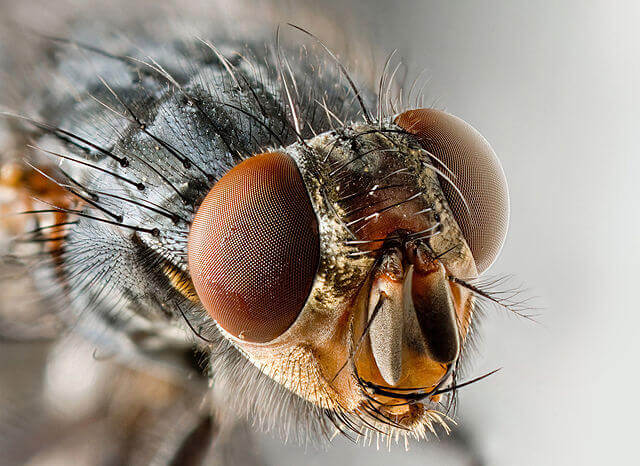Flies
Scientific Name: Diptera
The most common flies in your home are the house fly, face fly, stable fly, little house fly, and blow fly. Because flies breed in animal waste and decaying organic materials, they are carriers of pathogens including Salmonella, Staphylococcus, E. coli, and Shigella. These pathogens may cause serious diseases in humans and animals.

By JJ Harrison (This email address is being protected from spambots. You need JavaScript enabled to view it.) (Own work) [GFDL 1.2 or CC BY-SA 1.0], via Wikimedia Commons
Fly Identification
“Flies are adapted for aerial movement and typically have short and streamlined bodies. The first tagma of the fly, the head, consists of ocelli, antennae, compound eyes, and the mouthparts (the labrum, labium, mandible and maxilla make up the mouthparts). The second tagma, the thorax, bears the wings and contains the flight muscles on the second segment, which is greatly enlarged; the first and third segments have been reduced to collar-like structures. The third segment of the thorax bears the halteres, which help to balance the insect during flight. A further adaptation for flight is the reduction in number of the neural ganglia, and concentration of nerve tissue in the thorax, a feature that is most extreme in the highly derived Muscomorpha infraorder.[5]
Flies have a mobile head with eyes and in most cases have large compound eyes on the sides of the head, with three small ocelli on the top.”
Information provided by Wikipedia
Types of Flies
- Blow flies
- Bottle Fly
- Drain Fly
- Fruit Fly
- Gnats
- House Flies
- Phorid-Humpbacked Flies
Facts
- The life span of a fly can last from 8 days to two months. Some species can live up to a year.
- Flys only have two wings so they have to land often. Everytime they land, they spread harmful bacterias and pathogens that you could potentially come in contact with or ingest.
- Flies only feed on liquids or small granular foods.
Fly Prevention and Control
To keep flies out of your home, it is important to take out trash regularly, dispose of food and organic waste properly, and clean up any pet waste as soon as possible. To prevent flies from entering your residence use find mesh screens on your doors and windows.
The best way to remove flies from your home is to remove their habitat and breeding ground. Insecticides can be used as a supplement control but should never be poured down a drain, or used around food. Contact a pest control professional to inspect, diagnose, and treat your pest problem.
